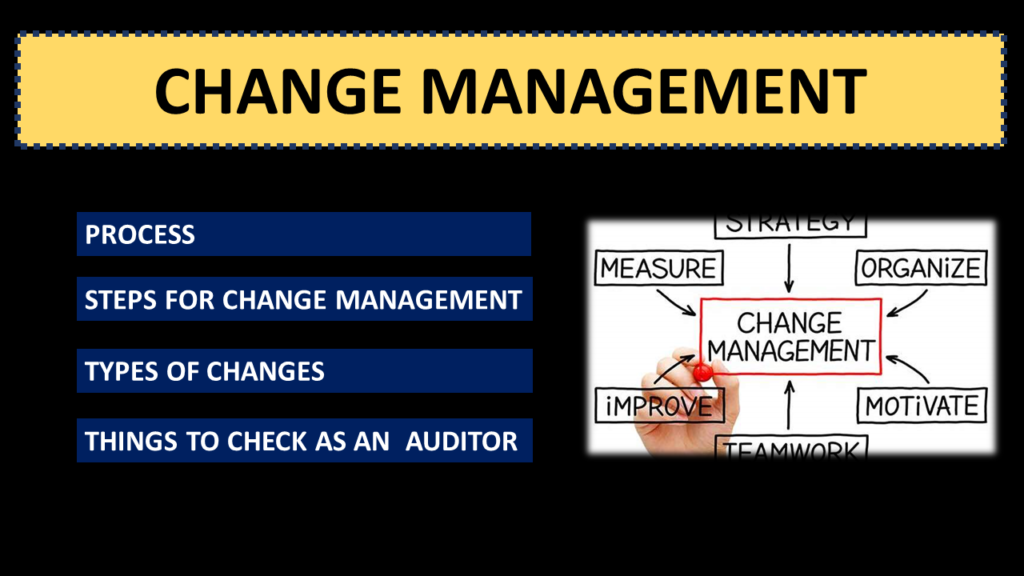In today’s dynamic IT landscape, organizations constantly undergo changes. Change management is a crucial process for ensuring these transitions are smooth, secure, and minimize disruptions to information security. This blog post explores what change management is, the different types of changes, the typical process followed, and what auditors look for during a change management audit.

What is Change Management?
Change management is the systematic approach of transitioning from one state to another. In information security, it focuses on managing modifications to systems and processes with minimal security risks. This involves assessing potential impacts, designing appropriate controls, and effectively communicating and coordinating the change process.
Examples of Changes in Information Security:
- Hardware Changes: Adding, upgrading, or replacing hardware like servers, firewalls, or storage devices. (Example: Upgrading network switches for better performance and security.)
- Software Changes: Deploying, upgrading, or patching software applications, operating systems, or security software. (Example: Installing the latest security patches on servers to address vulnerabilities.)
- Configuration Changes: Modifying settings of systems or network devices. (Example: Updating firewall rules to allow/block specific traffic based on security needs.)
- Policy Changes: Revising security policies, procedures, or guidelines to address evolving threats and business needs. (Example: Updating password policies to enforce stronger passwords or implementing a new data classification policy.)
Types of Changes
- Planned or Normal Changes: These are controlled and deliberate modifications, typically documented and approved by a change management board. (Examples: Implementing a new security policy or deploying a new security product.)
- Unplanned or Emergency Changes: These are unforeseen changes due to human error, system failures, or security incidents. (Example: Remediating a critical security vulnerability.)
The Change Management Process
The change management process typically involves these steps:
- Identify the Change: This could be driven by a new business need, a security vulnerability, or a technical issue.
- Assess the Impact: Identify the systems and processes affected by the change and potential security risks.
- Develop a Plan: Create a plan to implement the change, minimizing security risks. This should include rollback procedures in case of issues.
- Communicate the Change: Inform all stakeholders, including impacted employees and security teams.
- Implement the Change: Execute the change in a controlled and secure manner.
Change Management Audit Considerations
Auditors typically review these aspects of change management:
- Change Management Policy: Existence of a documented policy aligned with industry best practices.
- Change Request Process: Procedures for submitting change requests, including details about the change and its justification.
- Impact Assessment and Approval: Evidence of assessing change impact and obtaining approvals before implementation.
- User Acceptance Testing (UAT): Confirmation that UAT was conducted to verify the change functions as intended.
- Communication and Training: Documentation of communication plans and training provided to impacted personnel.
- Rollback/Backup Plans: Availability of rollback plans to revert to a previous state if necessary.
- Post-Implementation Review: Evidence of reviewing the implemented change’s effectiveness and addressing any identified issues.
Patch Management vs. Change Management
While both involve IT environment modifications, they have distinct purposes:
- Change Management: Focuses on a broader range of modifications, including hardware changes, software updates, configuration changes, and policy revisions. It ensures proper evaluation, planning, and execution to maintain system stability and security.
- Patch Management: Specifically addresses security vulnerabilities and software system stability. It involves identifying, acquiring, testing, and deploying software patches or updates.
Conclusion
Effective change management is vital for organizations to navigate IT changes securely. By following a structured change management process and addressing auditor considerations, organizations can minimize risks and ensure a smooth transition to a more secure IT environment.